Captain Jack Sparrow
Anti-cryptominer
- Joined
- Jul 1, 2007
- Messages
- 561
- Reaction score
- 118
There's gonna be a lot of pictures in this thread. Hopefully this will educate people as to why cheap PSUs are not actually better value for money. I was like this once - always buying cheap, low quality PSUs, and sticking by them.
Flouting everybody's advice here, just over a year ago, I bought an cheap £20 PSU while I was saving up for a branded one to install in a second PC. Five months later, this cheap PSU died overnight without any obvious cause. As it's going in the trash soon, I thought I'd take a look inside, maybe to find out the cause of failure, and why it seems very light compared to my current PSUs, which are from OCZ, Seasonic and Thermaltake.
It goes without saying, but I'll say it anyway...
Okay, let's get into the good stuff.
The PSU in question is an Alpine Silent PSU 600W "Gold".
Hmm, at first glance this doesn't actually look too bad, though there seems to be way too much power dedicated to the 3.3V and 5V rails. However, no 80 plus certification.
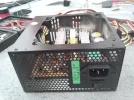
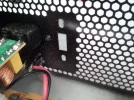
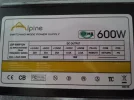
There's no active, or even passive PFC either. Looks like there was a space for a voltage switcher behind the green sticker, but it's not present.
Next, onto the connectors. What... only three molex?! Also, the PCI-E connectors are a cause of concern, more on this later.
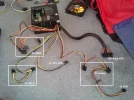
First, a couple of shots with the top off. All its suckiness is exposed, as well as its lack of components. Some areas where components were meant to be have been bridged across with wires. This explains why the PSU is so lightweight. At first glance, I can see that those transformers are just not big enough for a 600W PSU. Neither are the heatsinks. Furthermore, I can't see any obvious OEM markings or UL numbers on the circuit board.
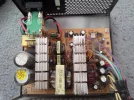
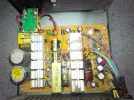
The primary side. This is where the AC line goes in, and filtering is applied to the line current.
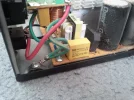
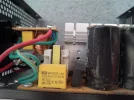
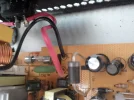
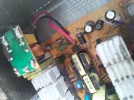
Not too bad. I can see two Y capacitors, two X capacitors and two coils. I have seen worse, some of the cheapest PSUs use very little components here.
The secondary side. This is where the output wires of the PSU are located, as well as some final filtering and smoothing components.
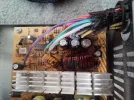
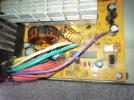
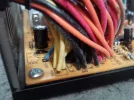
Notice the occupied 12V1 output and the unoccupied 12V2 output. Wonder if this PSU was meant to be a dual-rail?
Anyhoo, I can't seem to see any obvious cause of failure. So I'm assuming that the protection device is preventing the PSU from starting due to a failure condition. I guess you could say, at least the protection system works...
That said, I can see some discoloration around the resistors to the left of the top transformer, so they must have got pretty warm.

Now let's talk about the problems.
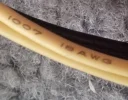
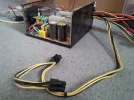
The output cables are all 18AWG. This isn't really a problem on its own, however the cables do look and feel flimsy. Notice that there's no cable sheathing on any cables, except for the ATX 20+4 pin connector.
Although there's two PCI-E connectors, notice how the second one is merely bridged in parallel off the first one. On quality power supplies, these would each have their own cables (typically thicker than 18AWG), as graphics cards can draw large amounts of power, which could melt these cables.
Lastly, all the capacitors are manufactured by "Canicon" (who are on the BadCaps avoid list), and "Cheng" (according to BadCaps, their quality is questionable). The failure of this PSU could possibly be related to failed capacitors, but I can't see any obvious ones.
Finally, the fan. It's a 120mm fan which I've already removed because this still works. The fan is suprisingly quiet for a cheap PSU. It does not move much air. From two metres, all I can feel from this fan is a little tickle of air. Compare that with some 80mm/92mm fans which can be clearly felt from two metres away, or even the Delta fans which feel like an industrial blower from 2 metres! This fan can't be used in a PC without modification because it uses a strange 2 pin connector (anyone know what this connector is called?). Some of the gold paint on the blades are already wearing off.
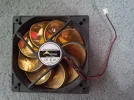

In conclusion, this is total garbage: No 80 plus certification, unknown "real" manufacturer, UL number absent, doesn't have the guts to deliver its advertised wattage and only survived half a year. Not worth sending back or diagnosing the failure any further, it's going in the trash!
Hope you've enjoyed reading this.
Happy gaming, and avoid these cheap gutless PSUs!
- Capt. Jack Sparrow.
Flouting everybody's advice here, just over a year ago, I bought an cheap £20 PSU while I was saving up for a branded one to install in a second PC. Five months later, this cheap PSU died overnight without any obvious cause. As it's going in the trash soon, I thought I'd take a look inside, maybe to find out the cause of failure, and why it seems very light compared to my current PSUs, which are from OCZ, Seasonic and Thermaltake.
It goes without saying, but I'll say it anyway...
You should not attempt to disassemble a PSU unless you are proficient with electronics, and you know what you're doing.
Power stored inside PSUs has the potential to be lethal and in some cases, actually has been (link). The PSU featured in this thread has been left unplugged for many months while it was in storage.
You have been warned.
NEVER ATTEMPT TO OPEN OR DISASSEMBLE A LIVE PSU!
You have been warned.
Okay, let's get into the good stuff.
The PSU in question is an Alpine Silent PSU 600W "Gold".
Hmm, at first glance this doesn't actually look too bad, though there seems to be way too much power dedicated to the 3.3V and 5V rails. However, no 80 plus certification.



There's no active, or even passive PFC either. Looks like there was a space for a voltage switcher behind the green sticker, but it's not present.
Next, onto the connectors. What... only three molex?! Also, the PCI-E connectors are a cause of concern, more on this later.

First, a couple of shots with the top off. All its suckiness is exposed, as well as its lack of components. Some areas where components were meant to be have been bridged across with wires. This explains why the PSU is so lightweight. At first glance, I can see that those transformers are just not big enough for a 600W PSU. Neither are the heatsinks. Furthermore, I can't see any obvious OEM markings or UL numbers on the circuit board.


The primary side. This is where the AC line goes in, and filtering is applied to the line current.




Not too bad. I can see two Y capacitors, two X capacitors and two coils. I have seen worse, some of the cheapest PSUs use very little components here.
The secondary side. This is where the output wires of the PSU are located, as well as some final filtering and smoothing components.



Notice the occupied 12V1 output and the unoccupied 12V2 output. Wonder if this PSU was meant to be a dual-rail?
Anyhoo, I can't seem to see any obvious cause of failure. So I'm assuming that the protection device is preventing the PSU from starting due to a failure condition. I guess you could say, at least the protection system works...
That said, I can see some discoloration around the resistors to the left of the top transformer, so they must have got pretty warm.

Now let's talk about the problems.


The output cables are all 18AWG. This isn't really a problem on its own, however the cables do look and feel flimsy. Notice that there's no cable sheathing on any cables, except for the ATX 20+4 pin connector.
Although there's two PCI-E connectors, notice how the second one is merely bridged in parallel off the first one. On quality power supplies, these would each have their own cables (typically thicker than 18AWG), as graphics cards can draw large amounts of power, which could melt these cables.
Lastly, all the capacitors are manufactured by "Canicon" (who are on the BadCaps avoid list), and "Cheng" (according to BadCaps, their quality is questionable). The failure of this PSU could possibly be related to failed capacitors, but I can't see any obvious ones.
Finally, the fan. It's a 120mm fan which I've already removed because this still works. The fan is suprisingly quiet for a cheap PSU. It does not move much air. From two metres, all I can feel from this fan is a little tickle of air. Compare that with some 80mm/92mm fans which can be clearly felt from two metres away, or even the Delta fans which feel like an industrial blower from 2 metres! This fan can't be used in a PC without modification because it uses a strange 2 pin connector (anyone know what this connector is called?). Some of the gold paint on the blades are already wearing off.


In conclusion, this is total garbage: No 80 plus certification, unknown "real" manufacturer, UL number absent, doesn't have the guts to deliver its advertised wattage and only survived half a year. Not worth sending back or diagnosing the failure any further, it's going in the trash!
Hope you've enjoyed reading this.
Happy gaming, and avoid these cheap gutless PSUs!
- Capt. Jack Sparrow.
Last edited:



